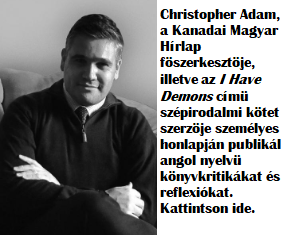Canadian Hungarian monument unveiled in Budapest
Hungarian Abstract / Magyar kivonat: Michaelle Jean, Kanada főkormányzója három emléktáblát avatott fel a budapesti Városligetben magyarországi látogatása során. A három nyelvű táblacsoport megemlékezik az 1956-os magyar bevándorlókról, illetve valamennyi magyar emigránsról, valamint arról az építő munkáról, mellyel hozzájárultak Kanada fejlődéséhez. A három tábla mellé pedig egy juharfát ültettek el és mind ez a központi 1956-os emlékműtől néhány lépésre található. A felavatáson szintén beszédet mondott Demszky Gábor, Budapest főpolgármestere.

The English-language plaque. (Photo: Judy Young-Drache)
Michaelle Jean, Governor General of Canada, unveiled a set of three plaques in Budapest’s City Park (Városliget) earlier this week, which commemorate the achievements of the more than 40,000 Hungarian refugees who arrived in Canada following the suppression of the 1956 Hungarian Revolution, as well as later waves of immigrants. Donated by the Canada Hungary Educational Foundation (CHEF) and the Rákoczi Foundation, the monument consists of Hungarian, English and a French plaques, all of which surround a newly planted maple tree. Very fittingly, the plaques were placed in close proximity to the main Hungarian monument commemorating the 1956 Revolution, which was erected on the occasion of the fiftieth anniversary of the uprising.
More than 200 guests were present during the unveiling, including Canadian ex-pats living in Budapest, representatives of the diplomatic community and dignitaries. Judy Young-Drache, president of the Canada-Hungary Educational Foundation, was also present. In her speech, Michaelle Jean noted that Canada was profoundly affected by the 1956 Revolution. „The tragedy of the Hungarian people, the plight of the refugees who arrived in our country by the thousands, profoundly touched Canadians. And it was with open arms, in a spirit of solidarity, out of respect for their suffering and admiration for their courage that they welcomed those women and men whose only fault was the desire to live free,” the Governor General explained. Gábor Demszky, Mayor of Budapest, also spoke on the occasion of the unveiling and noted that the 1956 refugees found in Canada a country that valued tolerance, human rights and openness. Demszky also pointed out that according to the latest census, 315,000 Canadian citizens indicated that they are (at least in part) of Hungarian origin.
Canadian Hungarian Journal / Kanadai Magyar Hírlap






12:09 du.
Ha én emléktáblát állítottam volna kanadai főkormányzóként, akkor csak annyi állt volna rajta, hogy „KANADA POLITIKAI VEZETÉSE BOCSÁNATOT KÉR A MAGYAR NEMZETTŐL AZÉRT, MERT 1956 ŐSZÉN CSERBEN HAGYOTT EGY SZABADSÁGÁÉRT KÜZDŐ NEMZETET ÉS A DEMOKRÁCIA ESZMÉJÉT.”
5:28 de.
Tökéletesen igaza van az emléktábla felíratára vonatkozóan a véleményező Szemenyei-Kiss Tamásnak. – 1956, majd éppen napjaink történelme mutat rá arra, hogy a magyar nemzet fiai ne kezeljék barátként, szövetségesként Kanadát. 1956 őszén Kanada semmit sem tett a véráztatta Magyarországért, ma pedig Irakba, Afganisztánba küld zsoldosokat, hogy letörjék a népek szabadságharcát.
A kanadai „demokrácia” éppen olyan, mint az USA „demokráciája”:
ez az ország az világ csendőre szerepében tetszelgő amerikai zsoldoshadsereg mellé szegődött rablóbanda.